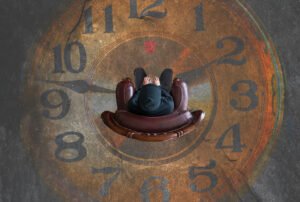
Alan Dettlaff is a University of Houston professor of social work and former social worker whose new book, Confronting the Racist Legacy of the American Child Welfare System, written with several collaborators, argues for abolishing the American child welfare system, especially its routine practice of the forced separation from their parents of as many as 200,000 children per year.
A cofounder of the upEND Movement, which seeks to overturn the American child welfare system (or, as opponents have termed it, “family policing” system), Dettlaff argues that the system is fundamentally racist, disproportionately and unfairly targeting Black families in particular, and inextricably bound to family separation practiced in chattel slavery.
In this conversation with NPQ, Dettlaff expands on this stance toward the child welfare system; his reasons for believing it to be broken beyond repair; and a vision for a system that protects children without breaking families apart. This interview has been edited for length and clarity.
NPQ: In your book, you make a point of connecting the idea of “family separation,” as it occurs all the time in the present-day child welfare system when children are put under the custody of the state, to the widely criticized family separation immigration policy of the Trump administration. Obviously, those are different scenarios—why do you feel it’s important and justifiable to make those comparisons?
Alan Dettlaff: We look at family separations as either a historical artifact, as what happened during the era of chattel slavery, when families were separated routinely by enslavers as a means of forcing compliance and subjugation of enslaved people; or as isolated incidents throughout our history, such as during the Japanese internment camps and then most recently during the [Trump administration’s] “zero tolerance” policy.
In reality, more than 70 percent of children in foster care today are in foster care because of what the system calls neglect, which is largely related to poverty issues. Less than 15 percent of children in foster care are in foster care because of physical or sexual harm. But I don’t think that’s widely known. Most people think that the child welfare system is saving children who need to be saved and is thus an indispensable tool in our society.
“This is largely happening to poor Black children. And our society has a history of turning a blind eye to poor Black children.”And I think because of that, the connections to these other types of family separations have not historically been made.
But there are decades of research that show how harmful family separation is both to children and to their parents. These are children whose parents are struggling. These are children whose mother has to make a decision between leaving her child home alone and going to work because she can’t afford childcare or staying at home with her child and then being fired from her job and not being able to afford rent or food for her child. Those are the kinds of situations that get people caught up in the child welfare system.
I think [it’s] important to also acknowledge the likelihood of or the presence of anti-Black racism that is involved in all of this. A big part of the reason why these family separations go unnoticed is because they don’t happen equally to all children. This is largely happening to poor Black children. And our society has a history of turning a blind eye to poor Black children. Rather than providing Black children and families with what they need to thrive in their homes and communities, we have a system that is punishing Black mothers for their poverty and then forcibly separating their families. I think that if this were happening equally to children of all races, or mostly to White children, it would be a different societal response.
NPQ: A central premise of your book is that a line can be drawn between family separation that occurred under slavery to the kind of family separation practiced today in the US child welfare system and the fact that Black children are highly overrepresented in the modern system. Can you elaborate on that and why the legacy of slavery is relevant to understanding the modern child welfare system?
AD: I think it’s important that people see the connections between the family separations that happened during the era of terror [of] slavery and the family separations that are happening today. Because, as I said before, we often think of family separations as this historical artifact rather than thinking of them as a continuum that the government has used to maintain the oppression of Black families.
Black codes [laws passed after the Civil War to enforce racial segregation] turned crimes that were formerly misdemeanors into felonies only if they were committed by Black people. And that was for the purpose of incarcerating Black adults and then leasing them out through convict leasing programs to create the system of free forced labor that was lost through [the] abolition of slavery. What’s often not talked about, and Dorothy Roberts does a very good job of talking about this in her book Torn Apart, is that the Black codes also allowed for the forced indentured servitude of Black children if the state could prove that those children’s parents were somehow “unfit.”
So, what we saw [was] thousands of Black children essentially enslaved through this system of forced indentured servitude, often to their former enslavers.
Black children didn’t become involved in the child welfare system until around the 1960s, when the idea of welfare changed significantly in the United States. As more and more Black families became eligible for those services, states started to pass…what we call [the] unsuitability clauses or immorality clauses, which would say that if there was a man living in the house who was unmarried, if there was a child or what they would call an illegitimate child in the home, then those families could be excluded from welfare services.
Louisiana, in the early 1960s, I believe, expelled about 20,000 children from their welfare rolls due to these unsuitability clauses. Over 90 percent of those children were Black. That created enough public outrage to lead to [a rule] that said that those unsuitability clauses could no longer be used. But it also said that all of the children who had been kicked off the state’s welfare rolls had to be investigated to determine if they were safe. So, then what you have is tens of thousands of Black children who are in poverty, kicked off welfare rolls, subsequently investigated by White caseworkers, and then entered [into] foster care. And that’s what started the beginning of the overrepresentation of Black children in the state’s care.
NPQ: You make the case that nationwide mandatory reporting laws passed in the early ’60s are a big part of what’s wrong with the child welfare system today—and why non-White children, Black children in particular, are overrepresented in it. What’s the connection?
AD: In 1962, there were 660 cases of child abuse reported to police. By 1968, when all states had a mandatory reporting law, that number grew to 11,000 cases, and Black children were significantly impacted by that. In 1968, 45 percent of all hotline calls were on Black children, even though Black children only represented about eight or nine percent of children in the population.
What was also happening concurrent to that that’s often not discussed is the Civil Rights movement. So, what we see is this rapid rise of mandatory reporting laws concurrent with horrific violence happening to Black Americans. You also have the [1965] Moynihan report, which blamed most of societal failures, particularly in poor, urban neighborhoods on Black motherhood and the lack of fathers in many Black families. So, you have really horrific violence against Black Americans, racial animus in the United States, and this rapid rise of mandatory reporting laws, which resulted in nearly half of all reports being on Black children once [those]…laws were [implemented].
“Mandatory reporting laws shifted the nature of child welfare services from poverty relief to investigation and surveillance.”
Fast forward a little bit to 1974, when the Child Abuse Prevention and Treatment Act (CAPTA) was passed that federalized mandatory reporting laws. It also solidified “neglect” as a category of maltreatment, basically opening this wide umbrella of categories that could be considered child maltreatment.
When we get to CAPTA, there was a decade’s worth of data showing that Black children and families were being significantly harmed by mandatory reporting laws. And there was testimony that if mandatory reporting laws [were] federalized, that Black children and families would be disproportionately harmed by that. But the legislators passed CAPTA anyway. So, when people talk about unintended consequences, I think that’s a misnomer when you know that something is going to cause…disproportionate harm to Black children and families, and you’re okay with that and you pass that law anyway, and then that disproportionate harm becomes realized. That’s not an unintended consequence.
Ever since 1974, because of mandatory reporting laws, we’ve seen the greatest levels of racial bias and racial disparities start at that mandatory reporting level. Mandatory reporting laws shifted the nature of child welfare services from poverty relief to investigation and surveillance.
Sign up for our free newsletters
Subscribe to NPQ's newsletters to have our top stories delivered directly to your inbox.
By signing up, you agree to our privacy policy and terms of use, and to receive messages from NPQ and our partners.
NPQ: I can see a lot of people hearing those arguments and thinking, “Okay, so maybe the system needs some reforming.” But you argue that calls for reform of the current system are counterproductive or even self-serving—that they just perpetuate the status quo. You argue for abolition. But why isn’t reform a good goal?
AD: Back in…1972, a book was published called Children of the Storm by Andrew Billingsley, pointing out the disproportionate overrepresentation of Black children in the child welfare system. [Over 50] years later now, that problem remains. Black children are still overrepresented in the child welfare system. Today, Black children account for close to 30 percent of children in foster care, even though they only represent about 13 or 14 percent of children in the general population. Black children are significantly more likely than White children to be reported to hotline calls. In fact, there’s research that shows that 53 percent of Black children in the United States will be subject to a child welfare investigation by the time they turn 18—that’s an incredible number of Black children who are going to be impacted by the system.
There’s research that shows that there are biases in the educational system and medical system. For example, in the medical system, there’s a lot of research [about] children who come to the hospital with an unexplained head injury.…If it’s a Black child, they’re [more likely to be] reported to Child Protective Services. There’s also research that shows that in the system, child welfare caseworkers are more likely to make a decision to remove Black children and to separate them from their families than White children.
The child welfare system has known about this disproportionality since the 1960s, and they’ve implemented reform after reform after reform. I was involved myself in many of those reform efforts, and my involvement in those reform efforts and then witnessing the failures of those reform efforts has led me to believe that abolition is the only solution—because the problem with the reforms is they never address the fundamental harm of the system, which is forcible family separation.
The system is built on this idea that taking children away from their parents is helpful, despite everything we know about the harm that it causes. So, reforms really just tinker around the edges. Until we as a society say that forcibly separating children from their families is wrong and we’re not going to do that anymore, the problem of the harm will continue.
NPQ: Is it always wrong? I mean, presumably, there are at least some cases where it’s not wrong.
AD: There are definitely extreme cases of abuse. I think what often happens is those extreme cases prevent us from having a conversation about abolition. It distracts from the fact that 70 percent of children in foster care are there because of poverty.
Abolitionists are not calling for [the] abolition of the system tomorrow. But what if we could just start with the 70 percent of the kids who are there because they’re poor? We’re looking for a gradual process to move toward abolition while simultaneously building up and really redirecting resources to children and families. If you think about the reality that more than $30 billion goes to the foster care industry right now, what if we start with those 70 percent of children who are in foster care because of poverty and took that [funding] that’s supporting their placements in foster care and redirected that to families and communities in need?
When there are cases of harm, though, the way I typically like to think about it is to ask people to think about their own families, their extended network of people that they love and care about, and imagine that a child in that network is harmed. And ask yourself, what would you want to happen? Do you want to get together as a family and a community, a network of people who love and care about each other, and figure out what needs to happen to protect that child from further harm? Or would you want the government to take that child away from you and figure it out for themselves? I think that when posed with that question, most people would choose the first option. And if you want that for your family, then you should want that for all families. And if you want that for all families, then that’s what abolition looks like.
“Equitable harm is still harm.”
NPQ: You’ve made the case that part of what’s wrong with the modern child welfare system is that it disproportionately focuses on or targets Black families. But you also argue that simply making the system more proportional isn’t the answer. Why not?
AD: Their goal right now is what they call racial equity, which is proportionality. And, you know, on the surface, that logic makes sense. If disproportionality is the problem, then proportionality—proportional representation—is the solution. But think about what that actually means. If we were to achieve racial equity or proportionality, that still means that hundreds of thousands of children are forcibly separated from their parents. It’s just distributed equitably by race. And when you have a system that’s fundamentally based on a harmful intervention, which is family separation, calling for equity only means that you’re equitably distributing harm, which shouldn’t be anyone’s goal. Equitable harm is still harm. So that shouldn’t be the goal for this system.
And even “equitable” harm or proportionality still disproportionately impacts Black children and families because of the racism that they experience every day in the United States. Black children in this country are already at greater risk than White children of living in poverty, of being homeless, of being jobless as an adult, of having substance use disorders, of being involved in the criminal legal system because of the daily experience of racism in the United States. When you then add forcible family separation and placement in foster care, which is also known to cause those societal problems, it’s just making it all the more likely that Black children and families will experience those outcomes.
NPQ: What are you hoping readers take away from this book?
AD: There have been times in our history [when] awareness of the horrors of family separation have spurred the nation to act. One of those times was during chattel slavery, [when] stories of families of children being torn from their mother’s arms were published in underground abolitionist newspapers sent to the North. And it was those stories of family separations that got mostly White Northerners on board with the abolition movement. It wasn’t the torture, the beatings, everything else that was horrible about slavery. It was that visceral understanding of how horrible it is for a baby to be snatched from his mother’s arms and sold away to strangers.
And then, just recent history, we saw that during “zero tolerance” [under Trump], [when] the nation was spurred to act, there were protests everywhere. If we could create that understanding about what’s happening in the child welfare system today that we know people can understand, then we’re hoping to move society, but also legislators. The idea is to build political will, to create some of the policy changes that we want to see, things like repealing mandatory reporting laws.
NPQ: Are the problems with our child welfare system you describe unique to the United States?
AD: There are definitely countries that use removal less, particularly…in instances of poverty, and that provide other forms of aid and assistance to families.
I think the US context is really unique because of the history and the current reality of racism and specifically anti-Black racism in this country. I think you can’t extract or separate how many people in the United States have been socialized to think about Black mothers over decades, from “welfare queens” to “crack babies” and all of those narratives.
A lot of the movement that we’re calling for is about redistribution of resources.
So, the idea I often give as an example is in Texas, we give foster parents about $900 a month. And what we’re really giving them money for is to take care of someone else’s child who’s been removed from their parents because their parents need money. But we give that money to a foster parent rather than giving that to the parent who needs it. That seems like a really simple solution, but it isn’t done because our society is comfortable using their tax dollars to give money to a stranger that we call a foster parent, but not giving that money directly to the mom who’s struggling to meet their child’s needs. And I think that’s fundamentally related to the deep problem of anti-Black racism in this country.











